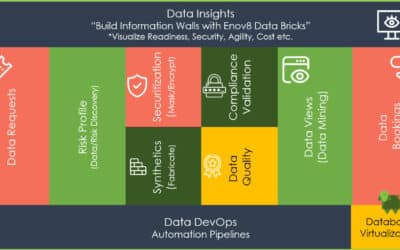
ITSM & ITOM, two pillars of effective IT & Test Environment Management
SEP, 2023
by Jane Temov.
Jane Temov is an IT Environments Evangelist at Enov8, specializing in IT and Test Environment Management, Test Data Management, Data Security, Disaster Recovery, Release Management, Service Resilience, Configuration Management, DevOps, and Infrastructure/Cloud Migration. Jane is passionate about helping organizations optimize their IT environments for maximum efficiency.
In the dynamic world of IT and software development, managing test environments efficiently and ensuring the seamless delivery of IT services is paramount.
Enov8 IT & Test Environment Manager
*Innovate with Enov8
Streamlining delivery through effective transparency & control of your IT & Test Environments.
This is where the combined forces of IT Operations Management (ITOM) and IT Service Management (ITSM) come into play, acting as the twin pillars upon which effective IT and Test Environment Management best practices are built.
What is IT & Test Environment Management?
IT and Test Environment Management is the disciplined practice of creating, provisioning, maintaining, and optimizing test environments for software development and testing activities. These environments mimic production systems to ensure that software applications are thoroughly tested before deployment. Their importance to the Software Development Lifecycle (SDLC) and the successful delivery of projects and change cannot be overstated:
- SDLC Catalyst: IT and Test Environment Management serve as catalysts within the SDLC, accelerating the development and testing phases by providing the necessary infrastructure and resources for teams to work efficiently.
- Risk Mitigation: Properly managed test environments reduce the risk of defects and issues in production systems. By simulating real-world scenarios, potential problems can be identified and resolved early in the development process.
- Project Delivery: For project managers and teams, efficient environment management is a critical factor in on-time project delivery. Delays caused by unavailable or unstable test environments can have a cascading effect on project timelines.
- Change Implementation: When implementing changes, whether they are software updates or infrastructure modifications, effective Test Environment Management ensures that these changes are thoroughly tested and validated before being rolled out to production environments.
Understanding ITOM and ITSM
IT Operations Management (ITOM):
ITOM encompasses the technical aspects of managing an IT infrastructure, including servers, networks, databases, and more. It focuses on ensuring the reliability, availability, and performance of IT systems. In the context of Test Environment Management, ITOM provides the foundation for creating and maintaining stable and consistent test environments. Here’s how ITOM contributes to best practices:
- Infrastructure Provisioning: ITOM tools and practices streamline the provisioning of servers, storage, and network resources required for creating test environments. This ensures that development and testing teams have the necessary infrastructure at their disposal when they need it.
- Monitoring and Optimization: ITOM involves continuous monitoring of infrastructure components. This proactive approach allows for the early detection and resolution of issues in test environments, minimizing downtime and disruption to testing activities.
- Configuration Management: Maintaining an accurate Configuration Management Database (CMDB) is essential for ITOM. In Test Environment Management, a well-maintained CMDB ensures that the test environments accurately reflect the configurations of production systems, supporting reliable testing.
IT Service Management (ITSM):
ITSM, on the other hand, focuses on aligning IT services with the needs of the business and ensuring a structured approach to managing IT processes. ITSM provides the framework for handling service requests, changes, and incidents effectively. Here’s how ITSM contributes to best practices:
- Change Management: Within the SDLC, Change Management processes ensure that any changes or updates to test environments are planned, documented, and approved. This minimizes the risk of introducing errors during testing.
- Incident Management: When issues arise during testing, Incident Management processes come into play. ITSM helps prioritize and resolve incidents swiftly, ensuring minimal disruption to testing schedules.
- Service Transition: ITSM’s Service Transition processes help coordinate the movement of changes from development to testing and eventually to production. This ensures that changes are properly tested and validated before being deployed into the production environment.
The Synergy of ITOM and ITSM
The real power of effective IT and Test Environment Management best practices lies in the synergy between ITOM and ITSM:
- Efficiency: By automating infrastructure provisioning and streamlining change and incident management, the synergy between ITOM and ITSM increases efficiency in the SDLC.
- Quality Assurance: Reliable test environments and structured processes lead to higher-quality software, reducing the chances of post-production issues.
- Business Alignment: Both ITOM and ITSM ensure that IT services, including test environments, are aligned with the business’s strategic objectives.
Conclusion: The Synergistic Umbrella of IT and Test Environment Management
In the intricate landscape of IT and software development, where the successful delivery of projects and changes hinges on meticulous planning and execution, two indispensable pillars emerge: IT Operations Management (ITOM) and IT Service Management (ITSM). These pillars, operating in unison, provide the solid foundation upon which effective IT and Test Environment Management best practices are built.
As we’ve explored the roles of ITOM and ITSM in the context of Test Environment Management, it becomes evident that they are complementary components of a larger ecosystem. They are the bedrock upon which test environments are constructed, maintained, and optimized to propel the Software Development Lifecycle (SDLC) forward.
But within this intricate framework, there exists another essential element—an “umbrella,” if you will—spanning across both ITOM and ITSM. This umbrella represents IT and Test Environment Management (TEM), a holistic discipline that orchestrates the convergence of these pillars. It operates at the intersection of technical infrastructure management and service-oriented processes, acting as a unifying force.
IT and Test Environment Management serves as the guardian of software quality, efficiency, and alignment with strategic business goals. It ensures that test environments are not mere replicas of production systems but are meticulously designed and maintained to mimic real-world scenarios. This meticulousness results in early issue detection, risk mitigation, and an enhanced capacity to deliver projects and implement changes seamlessly.
In this symbiotic relationship between ITOM, ITSM, and IT and Test Environment Management, efficiency thrives. The synergy between these components is a force multiplier, optimizing IT resources, streamlining processes, and elevating the quality of software products.
As we navigate the ever-evolving IT landscape, it’s crucial to recognize that effective IT and Test Environment Management isn’t a mere best practice—it’s a strategic advantage. By acknowledging the umbrella that unites ITOM and ITSM under its protective canopy, organizations can navigate the complex world of IT and software development with confidence, delivering projects and changes that meet and exceed expectations.
Relevant Articles
8 DevOps Anti-Patterns to Avoid
It’s the normal case with software buzzwords that people focus so much on what something is that they forget what it is not. DevOps is no exception. To truly embrace DevOps and cherish what it is, it’s important to comprehend what it isn’t. A plethora...
An Introduction to Application Rationalization
In today's fast-paced digital landscape, organizations often find themselves grappling with a sprawling array of applications. While these applications are crucial for various business operations, the lack of a structured approach to managing them can lead to...
What Makes a Great Test Data Management Tool
What Makes a Great Test Data Management Tool? In today's fast-paced IT landscape, having a robust Test Data Management (TDM) tool is crucial for ensuring quality, compliance, and efficiency in software development and testing. At Enov8, we pride ourselves on providing...
The Top Application Portfolio Management Tools
Managing an application portfolio is essential for organizations aiming to optimize their IT operations, reduce costs, and enhance overall efficiency. Application Portfolio Management (APM) tools are designed to help organizations achieve these goals by providing a...
What Is a Test Data Manager?
Testing is a critical aspect of software development, and it requires the use of appropriate test data to ensure that the software performs optimally. Test data management (TDM) is the process of creating, storing, and managing test data to ensure its quality,...
Sprint Scheduling: A Guide to Your Agile Calendar
Agile sprints can be a powerful, productive and collaborative event if managed properly. However, when neglected or set up incorrectly they risk becoming chaotic and inefficient. Crafting an effective schedule for your sprint is essential to ensure the success of your...










